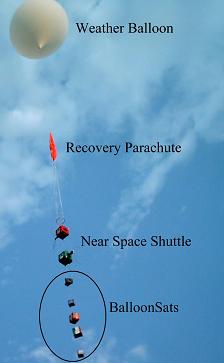
BalloonSat
Encyclopedia

ARHAB
Amateur Radio High Altitude Ballooning is the application of analog and digital amateur radio to weather balloons and was the name suggested by Ralph Wallio for this hobby. Often referred to as "The Poorman's Space Program", ARHAB allows amateurs to design functioning models of spacecraft and...
flights. One reason BalloonSats are simple is because they do not require the inclusion of tracking equipment; as secondary payloads, they already are being carried by tracking capsules.
Often the design of a BalloonSat is under weight and volume constraints. This encourages good engineering practices, introduces a challenge, and allows for the inclusion of many BalloonSats on an ARHAB flight. The airframe material is usually Styrofoam or Foamcore, as they are lightweight, easy to machine, and provide reasonably good insulation.
Most carry sensors, data loggers and small cameras operated by timer circuits. Popular sensors include air temperature, relative humidity, tilt, and acceleration. Experiments carried inside BalloonSats have included such things as captive insects and food items.
Before launch, most BalloonSats are required to undergo testing. These tests are designed to insure the BalloonSat will function properly and return science results. The tests include a cold soak, drop test, function test, and weighing. The cold soak test simulates the intense cold temperatures the BalloonSat will experience during its mission. A launch and landing can be traumatic, therefore the drop test requires the BalloonSat to hold together and still function after an abrupt drop. The function test verifies the BalloonSat crew can prep the BalloonSat at the launch site.

